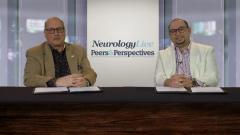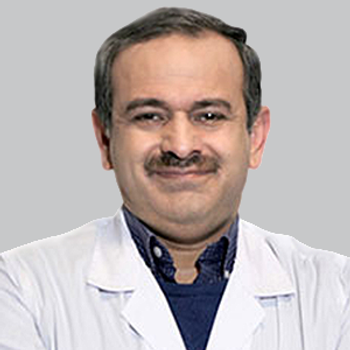
Disease-Modifying Therapies (DMTs) in Multiple Sclerosis (MS)
Mark S. Freedman, HBSc, MSc, MD, CSPQ, FAAN, FRCPC, provides an overview of disease-modifying therapies for the treatment of multiple sclerosis.
Episodes in this series

Ahmed Zayed Obeidat, MD, PhD: Hello and thank you for joining this NeurologyLive® Peers & Perspectives presentation entitled, “Optimizing Treatment of Relapsing-Remitting Multiple Sclerosis With Oral Therapies.” I am Dr Ahmed Obeidat, associate professor at the Medical College of Wisconsin in Milwaukee. Joining me today is Dr Mark Freedman. He’s a professor of medicine in the field of neurology at the University of Ottawa, as well as the director of the multiple sclerosis research unit at the Ottawa Hospital general campus, and the senior scientist at the Ottawa Hospital Research Institute in Ottawa, Canada.
Today we are going to discuss the use of oral therapies in the treatment of relapsing-remitting multiple sclerosis [MS]. We will discuss our rationale for treatment selection based on long-term and real-world data, and how recent and emerging therapeutic advances have and are likely to change the care of patients with relapsing-remitting multiple sclerosis. Thank you so much for joining us, and let’s begin. Welcome, Dr Freedman.
Mark S. Freedman, HBSc, MSc, MD, CSPQ, FAAN, FRCPC: Thank you.
Ahmed Zayed Obeidat, MD, PhD: Thanks for being with us today. We’re going to start by talking about the classes of disease-modifying therapies. Over the past 2 decades, we saw a large number of disease-modifying therapies come to market. We’re lucky, our patients are lucky because now we have options. We want to touch base on the different classes and the rationale for their development for the treatment of relapsing-remitting multiple sclerosis.
Mark S. Freedman, HBSc, MSc, MD, CSPQ, FAAN, FRCPC: It’s actually probably been 3 decades now from the first ever disease-modifying medication that was tried in MS. I think so much of this has evolved from our improved understanding of the underlying disease. That has improved so much that if you talk about autoimmune diseases in general, MS has become the prototypic autoimmune disease to test out various types of immune therapies. It’s clean when you compare it to some of the rheumatologic and other conditions where multiple systems are involved. In MS, it’s the central nervous system and that’s it. So we’ve been fortunate, but we’ve also done some hard work through clinical trials, and this has fostered a lot of interest from the industry to develop new therapies.
The classes of drugs that we’ve had have emerged from a basic understanding of what the immunology is. Starting with what we call immunomodulators. Before the immunomodulators, we used to poison everybody with chemotherapy, which not only took out the immune system, but also knocked out the hematopoietic system and had numerous adverse effects on various organs. It wasn’t conducive to any kind of long-term treatment for the patients. It was kind of the last hurrah, and patients got it way too late. So the development of the immunomodulator brought into perspective the idea that you could control the immune system, keeping the disease at bay, but not compromising the patient. So, the whole first class of immunomodulators, and we continue to use immunomodulators today, are able to somehow turn the disease off, but they’re not immunosuppressive. That gives them an ability to have a long-term safety record that is second to none.
Unfortunately for many patients, that modulation isn’t enough. They have more disease activity, and we need something stronger. But as we go into stronger, unfortunately we’re getting into the whole realm of the immunosuppressive therapies. Then there was a whole group of drugs that became very effective because we knew that the immune cells were somehow being generated outside the brain, but they needed to get inside the brain in order to cause disease. So what better way to control the disease than to stop them from getting into the brain?
Ahmed Zayed Obeidat, MD, PhD: That’s right.
Mark S. Freedman, HBSc, MSc, MD, CSPQ, FAAN, FRCPC: We had a therapy such as natalizumab, which will block the trafficking of these cells into the brain. We had the S1P [sphingosine-1-phosphate] receptor agonists, and there are now 5 of these we’re using. They all work the same way. They modulate the receptor on the surface of the lymphocyte through its normal migration in and out of lymph nodes. It’s kind of like when you go into the parking lot and you take the ticket, you go into the lymph node and in order to get out, you need the ticket, but the drug takes away the ticket.
Ahmed Zayed Obeidat, MD, PhD: That’s right. They can’t get out.
Mark S. Freedman, HBSc, MSc, MD, CSPQ, FAAN, FRCPC: They can’t get out. I call it the “Hotel California” effect. You know why?
Ahmed Zayed Obeidat, MD, PhD: Interesting, tell me why.
Mark S. Freedman, HBSc, MSc, MD, CSPQ, FAAN, FRCPC: Because you can check in, but you can never leave, if you listen to the song. That’s how the S1P receptor agonists work. Now, if they don’t control the disease, and think about it, they’re stopping these generated immune cells in the periphery from getting into the central nervous system. They’re still there, and if you stop these drugs….
Ahmed Zayed Obeidat, MD, PhD: They’re going after….
Mark S. Freedman, HBSc, MSc, MD, CSPQ, FAAN, FRCPC: They’re going to get into the brain. Those 2 classes of drugs—the blockers at the blood-brain barrier and the sequesterers into the lymph nodes—they’re fraught with the problem of rebound. So you have to be set for that. When you’re transitioning, and I think we’ll talk a bit later about sequencing, when you transition from any of these therapies, you have to keep in mind this rebound and mitigate against it.
Ahmed Zayed Obeidat, MD, PhD: It’s very important because you don’t want to cause harm there.
Mark S. Freedman, HBSc, MSc, MD, CSPQ, FAAN, FRCPC: Exactly. These antitrafficking drugs are also preventing normal immune surveillance. Think of it as the immune system goes in and out of organs looking for viruses, malignant transformation, and that sort of thing. That’s what the immune system does. Think of it as your night watchman going through a big office tower, and he’s got keys to all the offices. He’s walking in the hallways, goes in, checks out the offices, everything is good, closes the door. What do these antitrafficking drugs do? They take away the key. So now the night watchman can only roam the hallways. He has no idea what’s going on in the individual offices. That’s why we end up with problems like PML [progressive multifocal leukoencephalopathy]. Normally if your immune system was on guard, if you had the watchmen in there, we wouldn’t get PML.
Ahmed Zayed Obeidat, MD, PhD: It wouldn’t happen.
Mark S. Freedman, HBSc, MSc, MD, CSPQ, FAAN, FRCPC: We wouldn’t get PML, we wouldn’t get some of the other opportunistic infections, and you might not get any of the malignancies that we’ve seen. So there’s a finite time that I think you can use these drugs. One of the problems that occurs is unfortunately, we get older. As we age, our immune system naturally becomes more compromised, and that’s where a lot of the problems start to happen. You may have controlled the disease for a long time, and then as you start to get into your 50s, people get nervous about using drugs like natalizumab or the S1Ps long term because that’s where you start to see the issues.
Ahmed Zayed Obeidat, MD, PhD: How about immune senescence in relation to the disease itself? Is that something that’s going to help, or something that may not?
Mark S. Freedman, HBSc, MSc, MD, CSPQ, FAAN, FRCPC: No. I wanted to talk about it a bit later, but you’ve raised an important point, so let’s deal with it now. At what point might it be safe to even stop the disease-modifying therapy? Does the disease warrant treatment forever?
Ahmed Zayed Obeidat, MD, PhD: We don’t know.
Mark S. Freedman, HBSc, MSc, MD, CSPQ, FAAN, FRCPC: There’s this sense that as you age and with the senescence of the immune system, it also leads to a sort of natural fizzing out of the disease activity, and we see that. Because as the patient ages, there are fewer relapses, there’s less MRI activity. We’re still on guard against this progression that we don’t quite understand yet.
Ahmed Zayed Obeidat, MD, PhD: Exactly.
Mark S. Freedman, HBSc, MSc, MD, CSPQ, FAAN, FRCPC: Everything about the therapies that we’re giving is to slow or stop this disease progression, keep people from getting impaired, and that’s what their aim is. But maybe as the patient gets older, we don’t need it, or maybe we can de-escalate from some of the more suppressive therapies to something that may be safer in the long term.
Ahmed Zayed Obeidat, MD, PhD: A modulator or….
Mark S. Freedman, HBSc, MSc, MD, CSPQ, FAAN, FRCPC: None of that information is available today. We haven’t done the proper studies to know when it might be safe to de-escalate and when it might be possible to stop the drug with confidence that these patients are not going to reactivate.
Transcript edited for clarity
Newsletter
Keep your finger on the pulse of neurology—subscribe to NeurologyLive for expert interviews, new data, and breakthrough treatment updates.
































